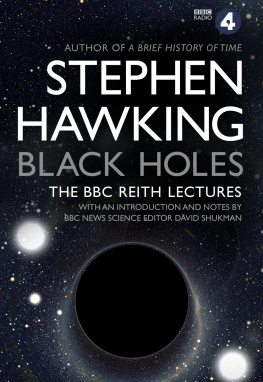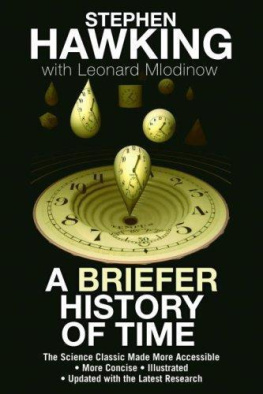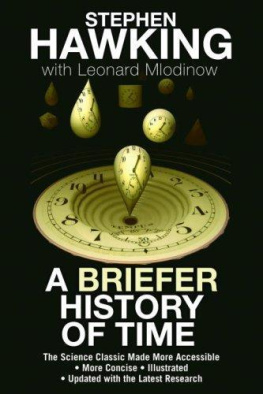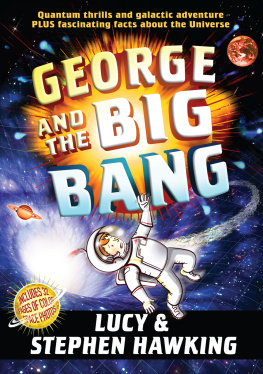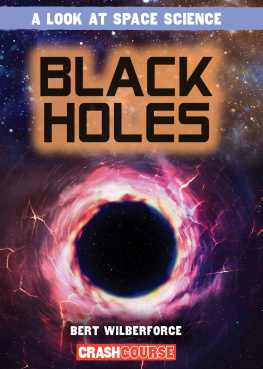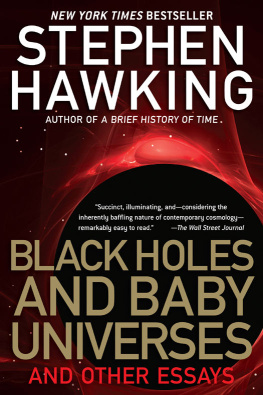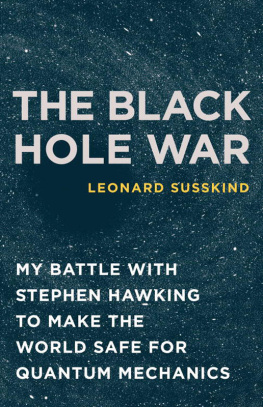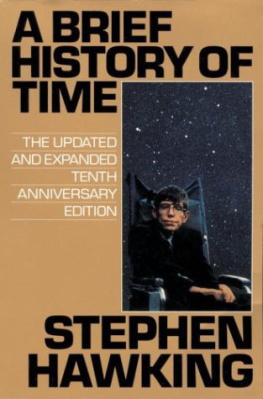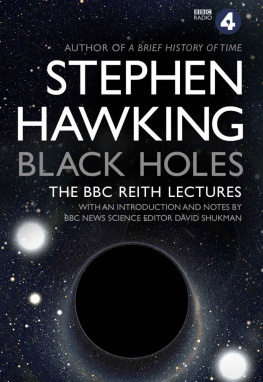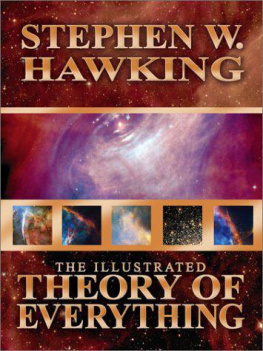Books by Stephen Hawking:
A Brief History of Time
Black Holes and Baby Universes and Other Essays
The Illustrated A Brief History of Time
The Universe in a Nutshell
My Brief History
With Leonard Mlodinow:
A Briefer History of Time
The Grand Design
With Lucy Hawking:
Georges Secret Key to the Universe
Georges Cosmic Treasure Hunt
George and the Big Bang
George and the Unbreakable Code
George and the Blue Moon
Black Holes: The BBC Reith Lectures
Stephen Hawking
With an introduction and notes by
BBC News Science Editor David Shukman
TRANSWORLD PUBLISHERS
6163 Uxbridge Road, London W5 5SA
www.penguin.co.uk
Transworld is part of the Penguin Random House group of companies whose addresses can be found at global.penguinrandomhouse.com
Do Black Holes Have No Hair? first broadcast by BBC Radio 4 on 26 January 2016.
Black Holes Aint As Black As They Are Painted first broadcast by BBC Radio 4 on 2 February 2016.
First published by arrangement with the BBC in Great Britain in 2016 by Bantam Books
an imprint of Transworld Publishers
Copyright Stephen Hawking 2016
Stephen Hawking has asserted his right under the Copyright,
Designs and Patents Act 1988 to be identified as the author of this work.
The illustrations were produced by Cognitive (wearecognitive.com) for BBC Radio 4.
The BBC Radio 4 logo is a trade mark of the British Broadcasting Corporation and is used under licence.
BBC Radio 4 2011.
A CIP catalogue record for this book
is available from the British Library.
Version 1.0 Epub ISBN 9781473541986
ISBN 9780857503572
This ebook is copyright material and must not be copied, reproduced, transferred, distributed, leased, licensed or publicly performed or used in any way except as specifically permitted in writing by the publishers, as allowed under the terms and conditions under which it was purchased or as strictly permitted by applicable copyright law. Any unauthorized distribution or use of this text may be a direct infringement of the authors and publishers rights and those responsible may be liable in law accordingly.
1 3 5 7 9 10 8 6 4 2
INTRODUCTION
by David Shukman
Everything about Stephen Hawking is a source of fascination: the plight of a genius trapped in an ailing body; the hint of a smile brightening a face in which only a single muscle can move; the distinctively robotic voice inviting us to share the exhilaration of discovery as his mind roams through the strangest corners of the Universe.
Against all the odds, this remarkable figure has transcended the usual boundaries of science. His book A Brief History of Time sold a staggering ten million copies. Cameo roles in popular comedy shows, invitations to the White House and a well-received movie about his life have confirmed him as a celebrity. He has achieved nothing less than becoming the most famous scientist in the world.
In the 1960s, he was given two years to live when he was diagnosed with motor neurone disease. But more than half a century later he is still researching, writing, travelling and regularly appearing in the news. His daughter Lucy, explaining this extraordinary drive, describes him as enormously stubborn.
Whether through the pain of his personal story or his ability to enthuse, Hawking captures the imagination. He recently warned that humankind faced a series of disasters of its own making from global warming to artificially engineered viruses and an article reporting his words was the most-read on the BBC website that day.
It is a terrible irony that such a great communicator cannot have a normal conversation. For interviews, the questions have to be sent in advance. Some years ago, his staff warned me not to attempt small talk because his answers even to the briefest questions take so long to compose. In the excitement of meeting him, however, I could not resist blurting out: How are you? and then had to wait guiltily for his reply. He was fine.
In his Cambridge office, a board is covered with equations. Mathematics of the most rarefied kind is the currency of cosmology. But Stephen Hawkings unique contribution to scientific research is to harness the approaches of apparently very different specialisms: most famously, he was the first to investigate the vast realm of space using scientific techniques devised to study the tiny particles inside atoms.
His colleagues in this fiendishly complex field might fear that their work can never be made intelligible to the public. Yet striving to reach a wider audience is a Hawking trademark. In this years BBC Reith Lectures, he rose to the challenge of summarizing a lifetimes insights into black holes in two fifteen-minute talks. And for those who are curious but perplexed, or enthralled by the ideas but nervous about the science, I have added notes at key points to offer a helping hand.
DO BLACK HOLES HAVE NO HAIR?
Broadcast 26 January 2016

IT IS SAID that fact is sometimes stranger than fiction, and nowhere is that more true than in the case of black holes. Black holes are stranger than anything dreamed up by science-fiction writers, but they are firmly matters of science fact. The scientific community was slow to realize that massive stars could collapse in on themselves, under their own gravity, and to consider how the objects left behind would behave. Albert Einstein even wrote a paper in 1939 claiming that stars could not collapse under gravity because matter could not be compressed beyond a certain point. Many scientists shared Einsteins gut feeling. The principal exception was the American scientist John Wheeler, who in many ways is the hero of the black hole story. In his work in the 1950s and 1960s, he emphasized that many stars would eventually collapse, and pointed out the problems that possibility posed for theoretical physics. He also foresaw many of the properties of the objects which collapsed stars become that is, black holes.
DS: The phrase black hole is simple enough, but its hard to imagine one out there in space. Think of a giant drain with water spiralling down into it. Once anything slips over the edge what is called the event horizon there is no way back. Because black holes are so powerful, even light gets sucked in, so we cant actually see them. But scientists know they exist because they rip apart stars that get too close to them and because they can send tremors through space.It was a collision between two black holes more than a billion years ago that triggered what are called gravitational waves, the recent detection of which was a hugely significant scientific achievement.
During most of the life of a normal star, over many billions of years, it will support itself against its own gravity by thermal pressure, caused by nuclear processes which convert hydrogen into helium.
DS: NASA describes stars as rather like pressure-cookers. The explosive force of nuclear fusion inside them creates outward pressure which is constrained by gravity pulling everything inwards.
Eventually, however, the star will exhaust its nuclear fuel. The star will now contract. In some cases, it may be able to support itself as a white dwarf star. However, Subrahmanyan Chandrasekhar showed in 1930 that the maximum mass of a white dwarf star is about 1.4 times that of the sun. A similar maximum mass was calculated by Soviet physicist Lev Landau for a star made entirely of neutrons.

